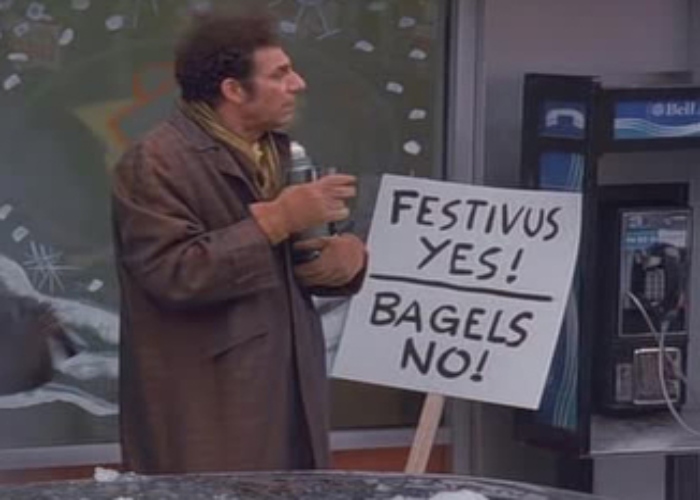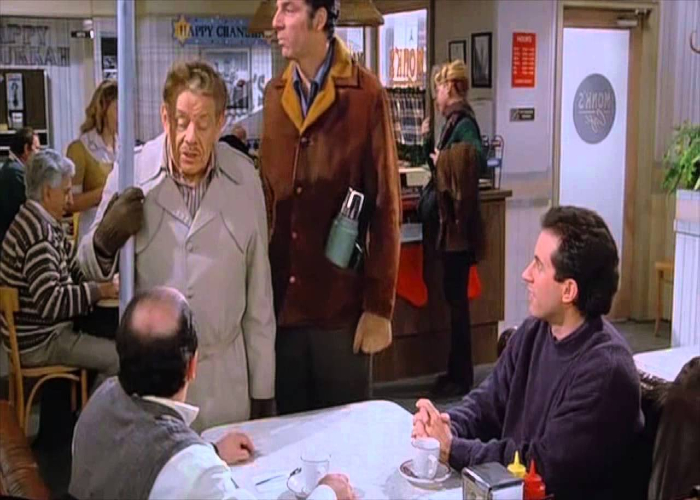
Seinfeld, a show about nothing, actually gave us something for the holidays: a new December tradition in which everyone can participate.
On December 18, 1997, all of us were introduced to Festivus, the holiday “for the rest of us.” Taking place on December 23rd, this celebration came about after George Costanza’s father Frank fought a heated physical battle for the last toy in a department store. He invented Festivus when he realized there had to be a better way, and developed the holiday focused on family disappointments and feats of strength instead of focusing on materialism.
That’s the history that most of us know, but is that the real origin? The truth is, that the roots of Festivus go back much further than that Seinfeld episode in 1997. Festivus actually got it’s start in 1966.

Back in 1966, Daniel O’Keefe, an editor at Reader’s Digest, celebrated the anniversary of his first date with his wife, Deborah, and named the party Festivus. Traditions began to evolve after O’Keefe was inspired by Samuel Beckett’s play Krapp’s Last Tape, which features and older man listening to tape recordings of his younger self. O’Keefe started making his own tapes, into which he would record his grievances about life; these tapings became incorporated into Festivus as the O’Keefe family began to record all their complaints too. In the original O’Keefe family tradition, grievance airings were not tied to any particular day and could occur any time between December and May. Grievance airings were also offered on annual themes. In addition to the tape recordings, there would be wrestling matches between O’Keefe’s three sons.
Many years later, O’Keefe’s son Daniel, became a writer for Seinfeld. He recounted the traditions to his fellow writers. The O’Keefe family traditions formed the basis of the Seinfeld Festivus. Ever since the airing of that episode in 1997, Festivus has taken on a life of its own. According to the Seinfeld tradition, the holiday features three primary elements:
- The Aluminum Pole: The holiday’s only decoration, the unadorned pole symbolizes resistance to the commercial aspect of the holidays. No tinsel is allowed, as Frank Costanza says it’s “distracting.”
- The Airing of Grievances: During the annual Festivus dinner, celebrants go around the table and tell their friends and family how they’ve disappointed them over the past year.
- The Feats of Strength: The head of the family must be wrestled to the ground in order for Festivus to end. The head of the family chooses an opponent; that person must then wrestle the head of the family unless it can be shown that they have something better to do.
Another aspect of the Festivus holiday is the Festivus Miracle…a miracle that is only slightly better than no miracle at all. Finding 35 cents in your pocket instead of a quarter would qualify. So would picking up the phone on the fifth ring just before the caller hangs up is another good example. Festivus miracles are all around us.
Seinfeld fans were delighted by the absurd holiday and took it for their own. And now we have a real holiday made fictional and then real again. Festivus parties have become popular with friends and families around the country. Many now put up their own aluminum poles for the holiday. Others have created Festivus greeting cards to list the ways they’ve been disappointed by others throughout the year.
In 2004, the holiday even moved into the public realm for the first time when in Bartow, Florida, a plywood sign stood next to other holiday displays. It read: “Festivus for the Rest of Us. Donated to Polk County by the Seinfeld Fan Club.” Some folks were not amused and aired their grievances to the county commissioners. But it looks like Festivus is here to stay. So enjoy your aluminum pole, and your feats of strength, and celebrate Festivus with the Rest of Us!

Be the first to comment